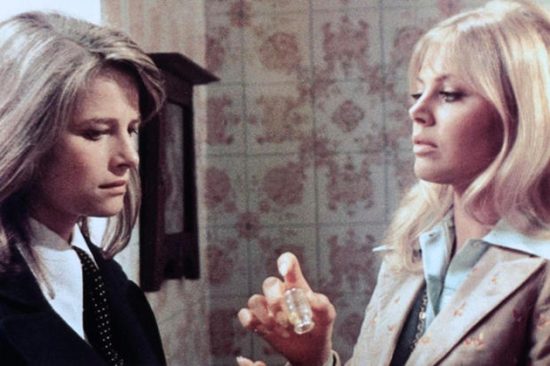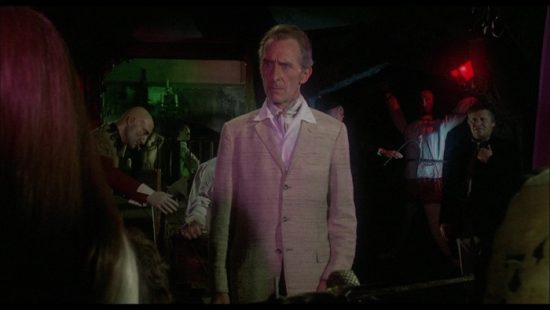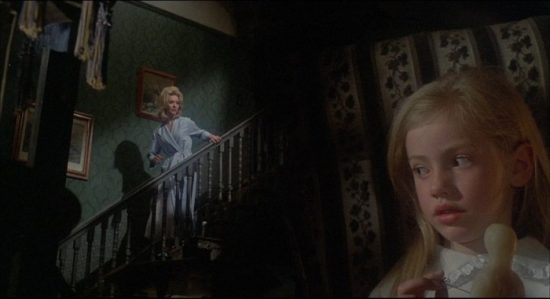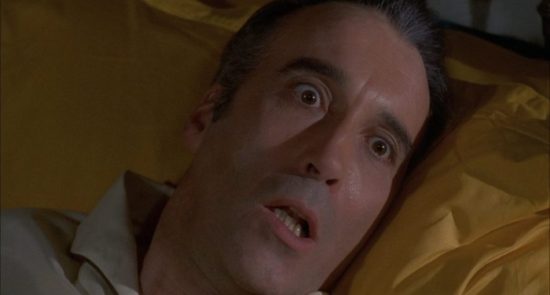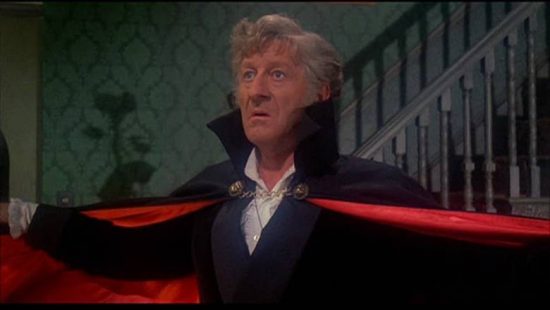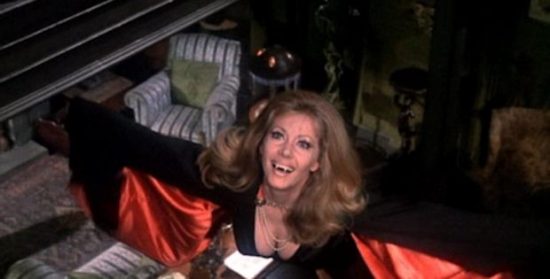Review: Amicus’ Asylum and The House That Dripped Blood
Second Sight is bringing us two very welcome limited edition Blu-Ray discs featuring some classic Brit-horror from Hammer’s arch-rival Amicus, famous for their “portmanteau” films which would offer up several short stories, tied together by a framing narrative. Despite their quick turnaround times and relatively low budgets, Amicus never skimped on paying for top thespian talent for these films, which many horror fans have tremendous affection for, and both films here – 1971’s The House That Dripped Blood, and 1972’s Asylum – boast some terrific names here, from Herbert Lom to Robert Powell, the great Peter Cushing and Christopher Lee, Ingrid Pitt (surely one of the all-time iconic Horror Queens?) and the one and only Jon Pertwee, while the stories and scripts come from the legendary Robert Bloch (Psycho). What a wonderful smorgasbord! Let’s start with Asylum.
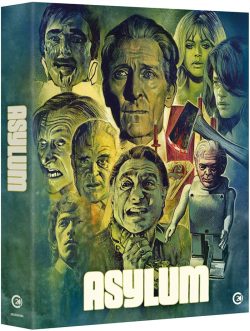 Directed by Roy Ward Baker
Directed by Roy Ward Baker
Starring Robert Powell, Barbara Perkins, Peter Cushing, Charlotte Rampling, Britt Ekland, Herbert Lom, Barry Morse, Patrick Magee, Richard Todd
Asylum’s framing device features a young Robert Powell, well before his international stardom with Jesus of Nazareth and The Thirty Nine Steps. Powell plays Doctor Martin, arriving at a remote former country house now housing the criminally insane, where the head of the asylum, Doctor Rutherford (the velvet-voiced Patrick Magee) has offered him a job if he can pass his test. One of the inmates is in fact Doctor Starr, the former head of the asylum before his own incident drove him into madness. Martin is to interview each of the inmates to see if he can discern which one is the former doctor, leading us into the four short films within the film.
Frozen Fear sees unfaithful husband Walter (D-Day veteran and Dambusters star Richard Todd) plotting with his lover to dispose of his rich wife Bonnie (Barbara Parkins), who holds the purse strings and the whip hand in their strained relationship, and doesn’t he just know it, his frustration evident in every syllable he utters to his wife. It’s no spoiler with this kind of story to tell you that he follows through on his plan to murder his wife, but the pleasure here is in seeing what happens next – Bonnie, you see, was a follower of a Voodoo priest, and killing her off is just the start of Walter’s nightmare…
The Weird Tailor has a pre-Space 1999 Barry Morse as a tailor, Bruno, now down on his luck, behind with the rent, engaged for a handsome fee by Mr Smith (Peter Cushing), for a very peculiar suit. He provides Bruno not only with some very unusual material (which has a very 1970s special effect changing-colour glow to it, perhaps a bit cheesy but quite fun and suitable for the era) but very specific instructions requiring him to work only at certain nocturnal hours. The suit is for a very unusual customer and purpose, that will enmesh the two – both desperate men, but for different reasons – into a strange, tragic tale.
In Lucy Comes to Stay, Martin interviews Charlotte Rampling’s Barbara. Barbara was released from some sort of unspecified care regime to return to the home she shares with her brother George (James Villiers), with Megs Jenkins’ Nurse Higgins in attendance to take care – an almost smothering care – of the troubled Barbara. It soon transpires that Barbara has an imaginary friend, the eponymous Lucy (Wicker Man’s Britt Ekland), who tries to persuade her to escape this care regime and sow dissension between her and her brother (reminding her that their parents left the home to her, not him). But is Lucy just a figment of Barbara’s imagination, of her illness, or something more?
The final vignette, Mannikins of Horror, is, for my money, the strongest of the suite and the most memorable, largely due to the presence of Herbert Lom as Doctor Byron. Byron is proud of his many doctorates and talks to Martin as a fellow professional at first, revealing his new interest, creating tiny toy robot-like figures with sculpted human heads on them – heads Martin recognises as people in the asylum. Byron, seems quite coherent and sensible as he talks to Martin, but he soon starts to expound on how he can project his astral body from his physical body, placing it into these small figures and controlling them to do his will, with one made with his own likeness and supposedly containing miniature organs and brain. Nonsense, of course, and he becomes agitated as Martin clearly doesn’t believe him. But what if this is no mere boast of a deluded mind? This story makes much of Lom, with numerous close-ups of his face that exert a real sense of the disturbingly weird, and builds to a very satisfying climax, which also serves to bring the short tales back into the closing part of the framing narrative.
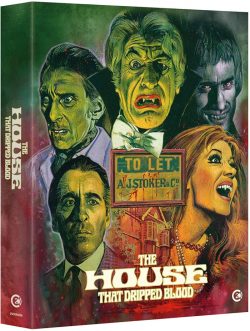 Directed by Peter Duffell
Directed by Peter Duffell
Starring Denholm Elliott, Joanna Dunham, Peter Cushing, Joss Ackland, Nyree Dawn Porter, Christopher Lee, Jon Pertwee, Ingrid Pitt
Bloch also performed writing and script duties for The House That Dripped Blood, again a set of four short tales, linked by a framing narrative, in this case Inspector Holloway (John Bennet), investigating the mysterious disappearance of a famous actor, Paul Henderson (the great Jon Pertwee), from the old country home he had rented while shooting a film nearby. Holloway, as he investigates, discovers the same house has been home to more than just this one mystery, almost as if it is cursed…
Method For Murder opens this collection of tales, with Denholm Elliott’s horror author Charles Hillyer and his wife Alice (Joanna Dunham), renting the house as an ideal spot for him to deal with some writer’s block and get on with a new book. But as Charles rediscovers his writing mojo and gets into his new book project, he is disturbed by hallucinations in which he glimpses Dominic (Tom Adams), the grotesque, psychotic central character of his new tale, a figure only he sees, in glimpses at first, through a window or the corner of his eye, but then closer and more threatening. Only Charles can see him, though, leading him to confide in his wife and his therapist that he fears he is losing his mind. But what if these are not just hallucinations? I was reminded a little of the much, much later Secret Window with Johnny Depp and John Turturo – perhaps these two tales would make a decent evening’s horror viewing!
Waxworks have always carried something of the Uncanny Valley about them, equally fascinating and somehow discomfiting at the same time, so it is no surprise to see a tale entitled Waxworks here. The wonderful Peter Cushing’s retiree Philip Grayson rents the house, looking for a bit of peace and quiet, and when he wants anything he drives into the nearby town, where he discovers the titular Waxworks. Drawn to it he finds himself in the Chamber of Horrors (of course, don’t we all when we visit a waxworks?), where he sees a figure of a woman who reminds him all too much of his own lost love. The owner – Wolfe Morris, exuding a deliciously creep air – tells Philip that visitors all appear to see in this figure’s face what they want to see, usually someone they have known. When Philip’s friend Neville (Joss Ackland) comes to visit his new home, he insists on patronising the waxworks in the town too, where he too is taken by the figure of the woman in the chamber of horrors, but what is it that draws them to it?
In Sweets to the Sweet we’re treated to another great – Christopher Lee – moving into the house with his young daughter, Jane Reid (Chloe Franks). Nyree Dawn Porter’s governess Ann Norton is less than impressed with Lee’s widower John Reid and the distant and seemingly puritan manner in which he treats the small girl. She is forbidden from going to school, only to be educated by Ann in the seclusion of the home, restricted from playing with other children, he even reacts furiously when Ann, growing close to the child, buys her some toys, including a doll. He maintains he has his reasons and it is hinted that they are linked to his deceased wife, but what could drive a father to be this way with his only child?
Closing out these short stories we have the great Jon Pertwee, partnered up with Brit-horror icon Ingrid Pitt. Pertwee is playing a famous actor, Paul Henderson (the one whose disappearance the inspector is investigating in the framing narrative), the classic, over-bearing, “I’m the Star” type of egotistical, “do you know who I am?” kind of actor, renting the house while shooting a horror film at a nearby studio. Paul is to play a vampire in the film, but he is contemptuous of the young director, of the quality of the set and his costume. He declares he will find something better himself and in visiting a peculiar old shop and explaining he requires the sort of cape that a “Transylvanian Vampire might wear” gets much more than he ever bargained for… This one really relied on Pertwee using his booming voice and his remarkable range of expressions, and the inclusion of Ingrid Pitt (Carmilla/Countess Dracula herself!) is the icing on the cake for any old-school horror fans.
Like many horror fans I have long had a tremendous affection for these portmanteau films – they are, in many ways, the cinematic equivalent of reading the old Weird Tales, Uncanny or Eerie comics, or the collections like the Pan Best Horror series of books, short, juicy hits with a twist in the tail (or tale). The fact you can often see the twists coming doesn’t matter in the slightest, in fact, I think for some of us it is part of the fun with these films, as with the aforementioned comics and books, and of course there’s much to be enjoyed simply in the great cast assembled for these shorts, boasting a Who’s Who of Brit thespians of the period, with a number of Hammer regulars moonlighting here for Amicus (including behind the scenes talent too, such as Asylum’s Roy Ward Backer directing).
Asylum and The House That Dripped Blood are both being released on special Limited Edition Blu-Ray by Second Sight Films from July 29th, with a host of extras, including Director’s Commentary, interviews, features (including vintage pieces with some of the cast who are no longer with us), a rigid slipcase with new artwork by Graham Humphreys, a reversible poster and forty-page booklet).

